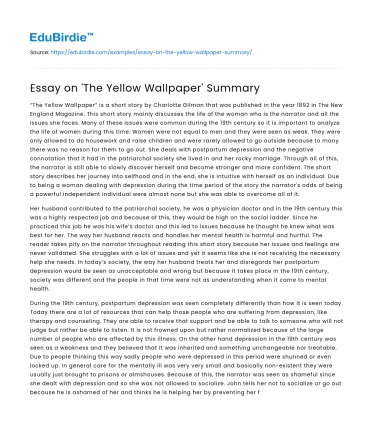“The Yellow Wallpaper” is a short story by Charlotte Gilman that was published in the year 1892 in The New England Magazine. This short story mainly discusses the life of the woman who is the narrator and all the issues she faces. Many of these issues were common during the 19th century so it is important to analyze the life of women during this time. Women were not equal to men and they were seen as weak. They were only allowed to do housework and raise children and were rarely allowed to go outside because to many there was no reason for them to go out. She deals with postpartum depression and the negative connotation that it had in the patriarchal society she lived in and her rocky marriage. Through all of this, the narrator is still able to slowly discover herself and become stronger and more confident. The short story describes her journey into selfhood and in the end, she is intuitive with herself as an individual. Due to being a woman dealing with depression during the time period of the story the narrator's odds of being a powerful independent individual were almost none but she was able to overcome all of it.
Her husband contributed to the patriarchal society, he was a physician doctor and in the 19th century this was a highly respected job and because of this, they would be high on the social ladder. Since he practiced this job he was his wife’s doctor and this led to issues because he thought he knew what was best for her. The way her husband reacts and handles her mental health is harmful and hurtful. The reader takes pity on the narrator throughout reading this short story because her issues and feelings are never validated. She struggles with a lot of issues and yet it seems like she is not receiving the necessary help she needs. In today’s society, the way her husband treats her and disregards her postpartum depression would be seen as unacceptable and wrong but because it takes place in the 19th century, society was different and the people in that time were not as understanding when it came to mental health.
Save your time!
We can take care of your essay
- Proper editing and formatting
- Free revision, title page, and bibliography
- Flexible prices and money-back guarantee
During the 19th century, postpartum depression was seen completely differently than how it is seen today. Today there are a lot of resources that can help those people who are suffering from depression, like therapy and counseling. They are able to receive that support and be able to talk to someone who will not judge but rather be able to listen. It is not frowned upon but rather normalized because of the large number of people who are affected by this illness. On the other hand depression in the 19th century was seen as a weakness and they believed that it was inherited and something unchangeable nor treatable. Due to people thinking this way sadly people who were depressed in this period were shunned or even locked up. In general care for the mentally ill was very very small and basically non-existent they were usually just brought to prisons or almshouses. Because of this, the narrator was seen as shameful since she dealt with depression and so she was not allowed to socialize. John tells her not to socialize or go out because he is ashamed of her and thinks he is helping her by preventing her from looking bad. “John has cautioned me not to give way to fancy in the least. He says that with my imaginative power and habit of story-making, a nervous weakness like mine is sure to lead to all manner of excited fancies”(Gilman, 649). He doesn’t want her to embrace her natural creativity because to him it’s a weakness and as a result instead of helping her overcome her depression, this just makes her even more depressed.
The patriarchy at this time was glossed over and seen as caring, in the story, John is praised for his patience and willingness to take care of his wife who is deemed “crazy” or “mad.” She is controlled by her husband and if she tries to express herself he usually shuts her down. For example, when she is explaining her feelings towards the house “[T]here is something strange about the house—I can feel it. I even said so to John one moonlight evening, but he said what I felt was a draught, and shut the window”(Gilman, 648). This quote gives an example of how badly she was treated by her husband, she feels something strange in the house, and instead of taking her feelings into consideration and having a conversation and hearing his wife as to why she feels this way John disregards her and tells her that she is not feeling what she thinks. He said that all she was feeling was a draught and his solution was to just isolate her even more from life by telling her to shut the window.
The yellow wallpaper in the nursery demonstrates the narrator’s feelings throughout the story.
Did you like this example?
Make sure you submit a unique essay
Our writers will provide you with an essay sample written from scratch: any topic, any deadline, any instructions.
Cite this paper
-
APA
-
MLA
-
Harvard
-
Vancouver
Essay on ‘The Yellow Wallpaper’ Summary.
(2024, January 18). Edubirdie. Retrieved January 11, 2025, from https://edubirdie.com/examples/essay-on-the-yellow-wallpaper-summary/
“Essay on ‘The Yellow Wallpaper’ Summary.” Edubirdie, 18 Jan. 2024, edubirdie.com/examples/essay-on-the-yellow-wallpaper-summary/
Essay on ‘The Yellow Wallpaper’ Summary. [online].
Available at: <https://edubirdie.com/examples/essay-on-the-yellow-wallpaper-summary/> [Accessed 11 Jan. 2025].
Essay on ‘The Yellow Wallpaper’ Summary [Internet]. Edubirdie.
2024 Jan 18 [cited 2025 Jan 11].
Available from: https://edubirdie.com/examples/essay-on-the-yellow-wallpaper-summary/
copy






 Stuck on your essay?
Stuck on your essay?

